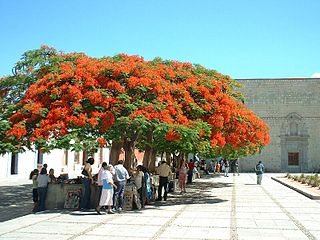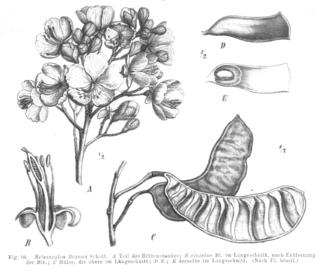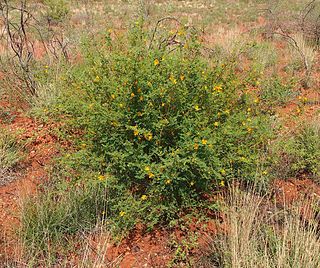
Caesalpinioideae is a botanical name at the rank of subfamily, placed in the large family Fabaceae or Leguminosae. Its name is formed from the generic name Caesalpinia. It is known also as the peacock flower subfamily. The Caesalpinioideae are mainly trees distributed in the moist tropics, but include such temperate species as the honeylocust and Kentucky coffeetree. It has the following clade-based definition:
The most inclusive crown clade containing Arcoa gonavensisUrb. and Mimosa pudicaL., but not Bobgunnia fistuloides(Harms) J. H. Kirkbr. & Wiersema, Duparquetia orchidaceaBaill., or Poeppigia proceraC.Presl

Melanoxylum is genus of plants in the legume family, Fabaceae. It includes a single species, Melanoxylum brauna, the yellow-flowered brauna tree. It is native to eastern Brazil. The genus is part of subfamily Caesalpinioideae.

The subfamily Detarioideae is one of the subdivisions of the plant family Fabaceae (legumes). This subfamily includes many tropical trees, some of which are used for timber or have ecological importance. The subfamily consists of 84 genera, most of which are native to Africa and Asia. Pride of Burma and tamarind are two of the most notable species in Detarioideae. It has the following clade-based definition:
The most inclusive crown clade containing Goniorrhachis marginataTaub. and Aphanocalyx cynometroidesOliv., but not Cercis canadensisL., Duparquetia orchidaceaBaill., or Bobgunnia fistuloides(Harms) J. H. Kirkbr. & Wiersema.
Stuhlmannia moavi is a species of flowering plants in the legume family, Fabaceae. It is the only species in the genus Stuhlmannia. It is a tree native to Kenya, Tanzania, and Madagascar, where it grows in seasonally-dry tropical forest, woodland on limestone, and in riverine forest. The genus belongs to tribe Caesalpinieae in subfamily Caesalpinioideae.
Vouacapoua is a genus of legume in the family Fabaceae, subfamily Caesalpinioideae. It includes three species of trees native to northern South America, ranging from the Guianas to northern and northeastern Brazil. They grow in terre firme Amazonian rain forest.

Peltophorum is a genus of 5–15 species of flowering plants in the family Fabaceae, subfamily Caesalpinioideae. The genus is native to certain tropical regions across the world, including northern South America, central and southern Africa, Indochina, southeastern China, Malesia, New Guinea, and northern Australia. The species are medium-sized to large trees growing up to 15–25 m tall, rarely 50 m.
Arcoa is a genus of flowering plants in the family Fabaceae. It belongs to the subfamily Caesalpinioideae. Arcoa is monotypic, with the single species Arcoa gonavensis. It is a shrub or tree endemic to Hispaniola.
Lophocarpinia aculeatifolia is a species of flowering plants in the legume family, Fabaceae. It is the sole species in genus Lophocarpinia. It is a tree native to Paraguay and northern Argentina. It belongs to tribe Caesalpinieae of subfamily Caesalpinioideae.

Recordoxylon is a genus of flowering plants in the legume family, Fabaceae. It includes three species of trees native to the tropical Amazon rainforest of northern South America, and the species' range includes northern Brazil, Colombia, French Guiana, Guyana, and Venezuela. Habitats include non-flooded rain forest on terra firme, seasonally-flooded riverine forest (várzea), and montane forest.
Stenodrepanum bergii is a species of flowering plants in the legume family, Fabaceae. It is a perennial subshrub native to northern Argentina. It is the sole member of genus Stenodrepanum. It belongs to tribe Caesalpinieae in subfamily Caesalpinioideae.

Petalostylis is a genus of flowering plants in the legume family Fabaceae. It is endemic to Australia, and includes two species of shrubs native to arid tropical areas of Queensland, New South Wales, South Australia, the Northern Territory, and Western Australia, where it grows on sand plains, stony ridges and rocky outcrops, creek beds, and scree slopes. It belongs to the subfamily Dialioideae.
Baudouinia is a genus of flowering plants in the legume family, Fabaceae. It includes six species which are all endemic to Madagascar. It belongs to the subfamily Dialioideae.

Piliostigma is a genus of flowering plants in the legume family, Fabaceae. It includes five species of small deciduous trees native to sub-Saharan Africa, the Indian subcontinent, Indochina, Java, the Philippines, and northern Australia. It belongs to the subfamily Cercidoideae and the tribe Bauhinieae. It is dioecious, with male and female flowers on separate plants.
Sphinga prehensilis is a species of flowering plant in the legume family, Fabaceae. It is a perennial shrub endemic to Cuba. It belongs to the mimosoid clade of the subfamily Caesalpinioideae.

Wallaceodendron celebicum is species of flowering plant in the legume family, Fabaceae. It is a tree native to the Philippines and Sulawesi. Typical habitat is tropical coastal and inland rain forest from sea level to 850 meters elevation. It is the sole species in genus Wallaceodendron. The genus belongs to the mimosoid clade of the subfamily Caesalpinioideae.

Amblygonocarpus is a genus of flowering plants in the legume family, Fabaceae. It contains a single species, Amblygonocarpus andongensis, a tree is native to sub-Saharan Africa. The genus belongs to the mimosoid clade of the subfamily Caesalpinioideae.
Lemurodendron is a genus of flowering plants in the legume family, Fabaceae. It contains a single species, Lemurodendron capuronii, a tree endemic to Madagascar. It belongs to the mimosoid clade in the subfamily Caesalpinioideae.
Piptadeniopsis lomentifera is a species of flowering plant in the legume family, Fabaceae. It is a tree native to southwestern Bolivia and Paraguay. It is the sole species in genus Piptadeniopsis. It belongs to the mimosoid clade of the subfamily Caesalpinioideae.

The subfamily Dialioideae is one of the subdivisions of the plant family Fabaceae (legumes). This subfamily includes many tropical trees and shrubs. The subfamily consists of 17 genera, which are widespread throughout the tropics. It has the following clade-based definition:
The most inclusive crown clade containing Poeppigia proceraC.Presland Dialium guianense(Aubl.) Sandwith, but not Cercis canadensisL., Duparquetia orchidaceaBaill., or Bobgunnia fistuloides(Harms) J. H. Kirkbr. & Wiersema
Uittienia modesta is a species of flowering plant in the legume family, Fabaceae. It is a tree native to Borneo and Sumatra. It is the sole species in genus Uittienia, which belongs to subfamily Dialioideae.









